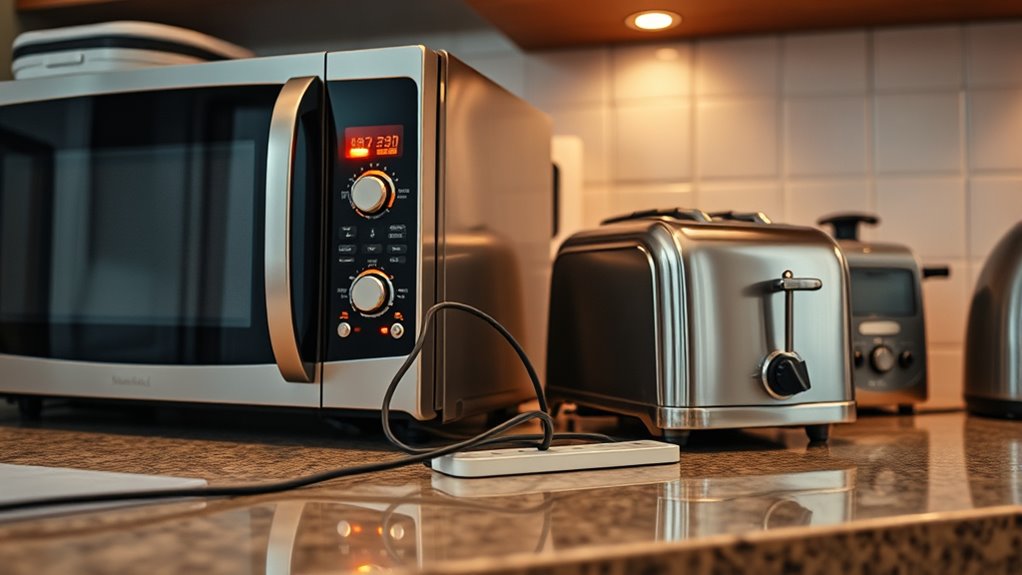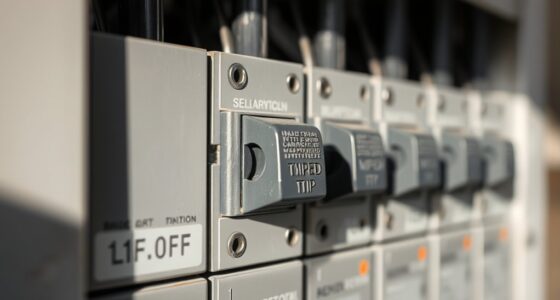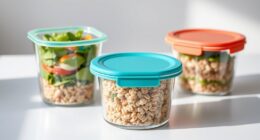To keep your kitchen safe, avoid sharing circuits between high-power appliances like blenders, toasters, and large ovens with low-power devices such as coffee makers or microwave ovens. Mixing these loads can overload circuits, trip breakers, or cause overheating, increasing fire and shock risks. Proper organization, like dedicating separate circuits for heavy-duty appliances, helps prevent hazards. Stay alert to signs of overload, and if you continue exploring, you’ll learn more about maintaining safe, efficient electrical setups.
Key Takeaways
- Keep high-power kitchen appliances like blenders and toasters on dedicated, separate circuits to prevent overloads.
- Avoid sharing circuits between microwave ovens, coffee makers, and other large countertop appliances.
- Match appliance wattage with circuit breaker ratings to prevent tripping and potential hazards.
- Regularly label circuits to identify connected devices and prevent accidental overloads.
- Use separate circuits for heavy-duty appliances to reduce fire risk and ensure safety.
Understanding Circuit Load Limits and Electrical Safety

To guarantee your kitchen appliances operate safely and efficiently, understanding circuit load limits and electrical safety is vital. You need to know how much power your circuits can handle to prevent overloads. A circuit breaker protects your wiring by shutting off power if a ground fault occurs or if the load exceeds its capacity. Ground faults happen when electricity leaks outside the intended pathway, posing a shock risk. Circuit breakers detect these faults quickly and trip, stopping potential hazards. Avoid overloading circuits by distributing appliances across different outlets and not exceeding the recommended load. Staying within load limits and ensuring the proper functioning of your circuit breaker minimizes fire risks and electrical accidents, keeping your kitchen safe and your appliances working effectively. Additionally, understanding electrical safety protocols can further reduce the risk of accidents and ensure your home’s electrical system remains reliable. Being aware of circuit capacity helps you better manage multiple small appliances without overtaxing your wiring. Regularly inspecting your electrical system and understanding load distribution techniques can also enhance overall safety. Moreover, consulting with a qualified electrician can help identify potential overload risks before they become hazardous. Proper maintenance and awareness of your circuit’s amperage limits can further prevent dangerous overloads and prolong the lifespan of your electrical components.
Appliances That Should Never Share a Circuit

Certain appliances in your kitchen draw so much power that sharing a circuit with other high-demand devices can be dangerous. To guarantee proper appliance compatibility and avoid overloading, keep these appliances on separate circuits. High-power devices often require larger circuit breaker ratings to handle their load safely. Avoid mixing:
- Microwave ovens, which can surge unexpectedly
- Toaster ovens and large countertop ovens
- Heavy-duty blenders or food processors
- Electric kettles or coffee makers with high wattage
Placing these on the same circuit risks tripping breakers or causing electrical hazards. Each appliance’s power demands vary, so it’s essential to match their requirements with appropriate circuit breaker ratings. Understanding circuit capacity helps prevent overloads and keeps your kitchen safe and functional. Additionally, knowing appliance power requirements can guide you in properly configuring your circuits to enhance safety and efficiency. For optimal safety, consider consulting a qualified electrician about circuit load management to ensure your kitchen’s electrical system is properly balanced. Being aware of personal safety precautions when working with electrical systems can further prevent accidents and ensure a secure environment.
The Risks of Combining High-Power and Low-Power Devices

Combining high-power and low-power devices on the same circuit can lead to serious electrical issues. When these devices draw different amounts of current, it can overload the circuit, causing the circuit breaker to trip unexpectedly. A ground fault may occur if a high-power device leaks current, risking shock or fire. Low-power devices, like small appliances, may not trigger the breaker quickly enough during a fault, leaving you vulnerable. Conversely, running high-power appliances with low-power devices can cause the breaker to trip more often, disrupting your tasks. Mixing loads also increases the chance of overheating wiring, which can lead to dangerous electrical fires. To stay safe, keep high-power appliances on dedicated circuits and avoid sharing them with low-power devices. Additionally, understanding the importance of proper electrical wiring can help prevent potential hazards. Ensuring that your wiring meets electrical safety standards is essential for preventing overloads and fires. Proper circuit design can further minimize these risks by appropriately distributing electrical loads. Awareness of load balancing techniques can enhance overall electrical safety in your home.
Best Practices for Organizing Your Kitchen Appliance Circuits

Organizing your kitchen appliance circuits effectively guarantees safety and guarantees your devices operate smoothly. Start by dedicating separate circuits for high-power appliances like blenders and toasters, preventing overloads. Use smart outlets to monitor and control energy use, reducing fire risks. Install circuit breakers rated for each circuit’s load to cut power during overloads. Group smaller appliances such as coffee makers and microwaves on dedicated circuits to avoid tripping. Label each circuit clearly so you know which outlets and devices are connected. Keep heavy-duty appliances on their own circuits to prevent interference. Consider installing additional outlets on separate circuits to improve safety and flexibility. Proper organization minimizes hazards and keeps your kitchen running efficiently. Additionally, reviewing your electrical panel setup can help identify potential overload points and optimize circuit distribution. Ensuring your circuit design aligns with your appliance needs also enhances overall safety and efficiency. Regularly inspecting your electrical wiring helps prevent potential hazards and maintains system integrity. Incorporating smart circuit monitoring can further enhance safety by providing real-time alerts on circuit performance. Staying informed about local electrical codes ensures your setup complies with safety standards and prevents future issues.
Recognizing Signs of Overloaded Circuits and When to Seek Help

If you notice frequent circuit breaker trips or flickering lights when using your kitchen appliances, it’s a clear sign that your circuits may be overloaded. Overloading can cause the circuit breaker to trip repeatedly to prevent damage or fire risks. Be alert for signs like appliances shutting off unexpectedly or outlets feeling warm. A ground fault may occur if moisture or damaged wiring causes current to escape, increasing the risk of shock or fire. If you experience repeated trips or suspect a ground fault, don’t disregard it—seek professional help. An electrician can evaluate whether your circuit breaker is properly rated or if your wiring needs upgrading. Recognizing these signs early helps prevent dangerous electrical issues and ensures your kitchen remains safe. Additionally, understanding electrical stress variations and the signs of electrical stress can help in maintaining a balanced and safe environment. Proper circuit capacity assessment can prevent overloads and ensure your appliances operate safely without risking damage or fire. Being aware of signs of overload can also help you take proactive steps before serious problems develop. Monitoring for nutrient-rich foods and maintaining proper grounding are also essential for overall safety.
Frequently Asked Questions
How Do I Calculate the Total Wattage for My Kitchen Appliances?
To calculate the total wattage for your kitchen appliances, add up each appliance’s wattage, which you can find on their labels. Make certain to include all appliances you plan to use simultaneously. Keep in mind your circuit capacity, typically 15 or 20 amps, and guarantee the combined appliance wattage doesn’t exceed it. This helps prevent overloads and keeps your electrical system safe and efficient.
Can I Use Extension Cords for High-Power Kitchen Appliances?
Using extension cords for high-power kitchen appliances is a huge mistake—you risk extension cord hazards and damaging your appliances. Never do it! These cords aren’t designed to handle the high appliance power ratings, and overloading them can cause fires or appliance failures. Instead, plug appliances directly into dedicated outlets, or install proper circuits. Your safety and appliances depend on following these rules—don’t gamble with extension cords!
What Safety Devices Protect Against Circuit Overloads in Kitchens?
You need a circuit breaker installed to protect your kitchen from overloads. It automatically trips when current exceeds safe levels, preventing wire overheating and fires. Overload protection is vital, especially with high-power appliances. Regularly check your breaker to guarantee it functions properly and replace it if it’s faulty. This safety device helps keep your kitchen safe by stopping electrical overloads before they cause damage or hazards.
Are There Specific Circuit Requirements for Built-In Kitchen Appliances?
Yes, built-in kitchen appliances require specific circuit requirements. You should plan appliance placement carefully to avoid overloading circuits, ensuring each appliance has its dedicated line if needed. Proper circuit labeling helps identify circuits easily for safety and maintenance. Always follow manufacturer instructions and local electrical codes, installing dedicated circuits for major appliances like dishwashers, ovens, or refrigerators. This setup enhances safety and prevents circuit overloads, keeping your kitchen safe and functional.
How Often Should I Have My Kitchen Electrical System Inspected?
Think of your kitchen’s electrical system as a garden that needs regular tending. You should have it inspected at least once every three to five years to catch any issues early. Regular appliance maintenance helps ensure safety and efficiency. During inspections, professionals check for electrical code compliance, loose connections, and potential hazards, giving you peace of mind that your kitchen remains safe and functional.
Conclusion
So, next time you’re tempted to load up one circuit with your blender, toaster, and that mysterious new gadget, remember: your kitchen isn’t a circus act. Keep high-power appliances apart, or you might just turn your home into a fireworks show. Play it safe, stay smart, and resist the urge to turn your kitchen into a chaotic energy frenzy. After all, your appliances will thank you—probably with fewer sparks and more cooking!









